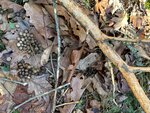While walking around my yard the other day, I came upon evidence that some unseen guest had been snacking on bark and defecating on the lawn. It didn’t take long to figure out who the culprit …
Stay informed about your community and support local independent journalism.
Subscribe to The River Reporter today. click here
This item is available in full to subscribers.
Please log in to continue |

While walking around my yard the other day, I came upon evidence that some unseen guest had been snacking on bark and defecating on the lawn. It didn’t take long to figure out who the culprit might be. It was one of the cutest critters we co-exist with here in the Upper Delaware River region—the Eastern cottontail rabbit.
Ranging between 15 to 19 inches in length and weighing between two to four pounds, cottontails are so named for their white puffy tail resembling a ball of cotton. Brown or grayish soft fur tapers to a lighter tan on top, with a white underbelly below.
Cottontail rabbits are often found in habitats featuring brushy areas such as thickets and briar patches, stubbly fields and brush piles and even farms and some residential areas. Our yard rabbits take advantage of various brush piles around the perimeter of the property.
Their survival depends upon knowing their territory well, including escape routes which can be accessed hastily if one of their many predators makes an appearance.
By observing their activities throughout the year, I’ve become familiar with some of their nesting sites and hiding spots. Fortunately for them, I am not among the pack of predators seeking sustenance at their expense.
Due to their desirability as prey animals, rabbits live relatively short lives in the wild, ranging between one to four years. Females bear an average of four litters per year, ranging from two to nine young in each. Nests are constructed in cups approximately six inches deep and lined with grasses and fur, which the female harvests from her own belly.
In 16 days, young are weaned, furred and able to exist independently.
Comments
No comments on this item Please log in to comment by clicking here